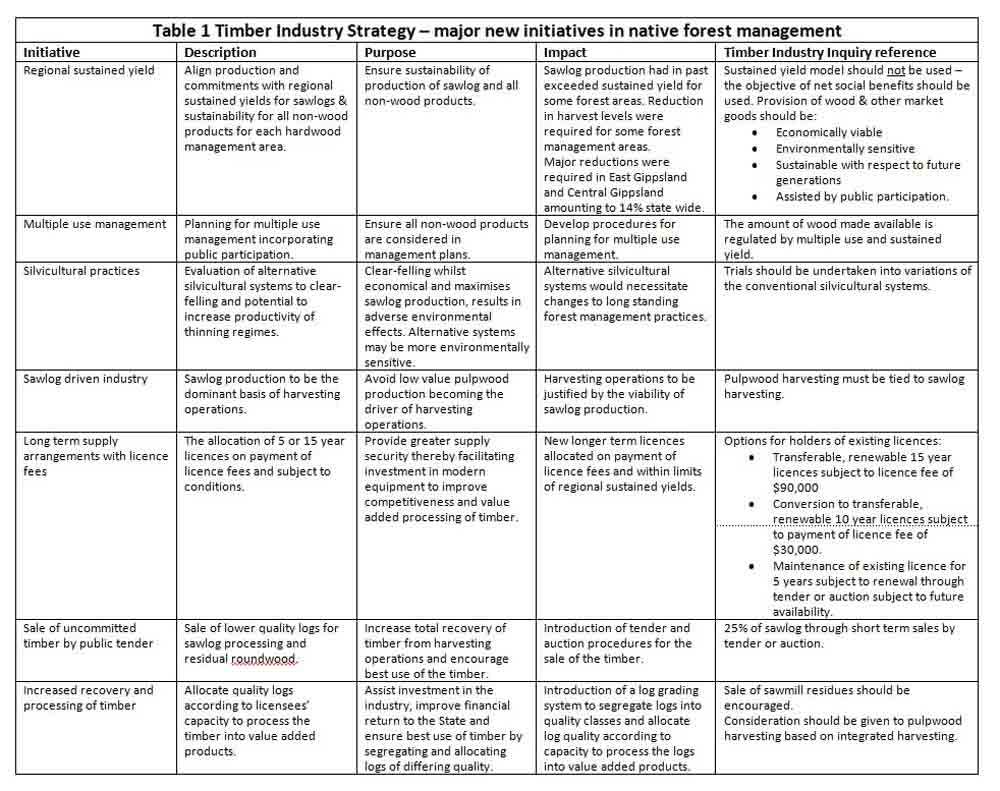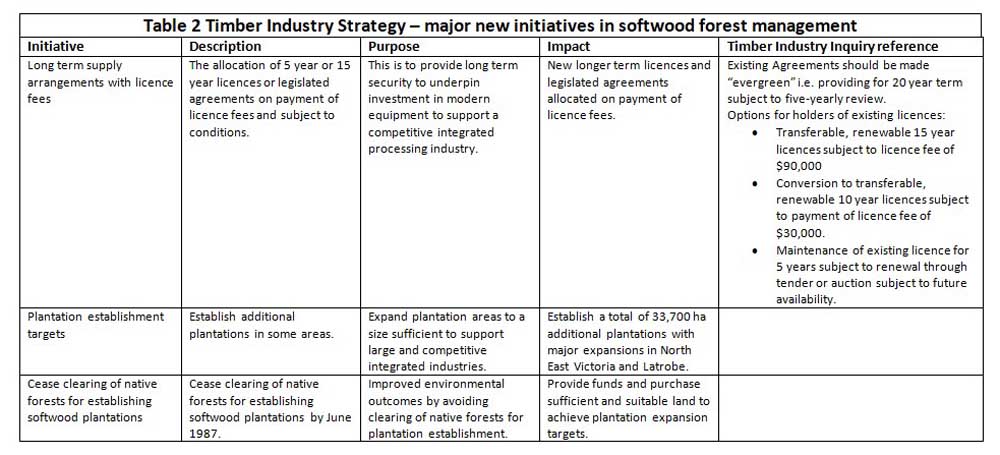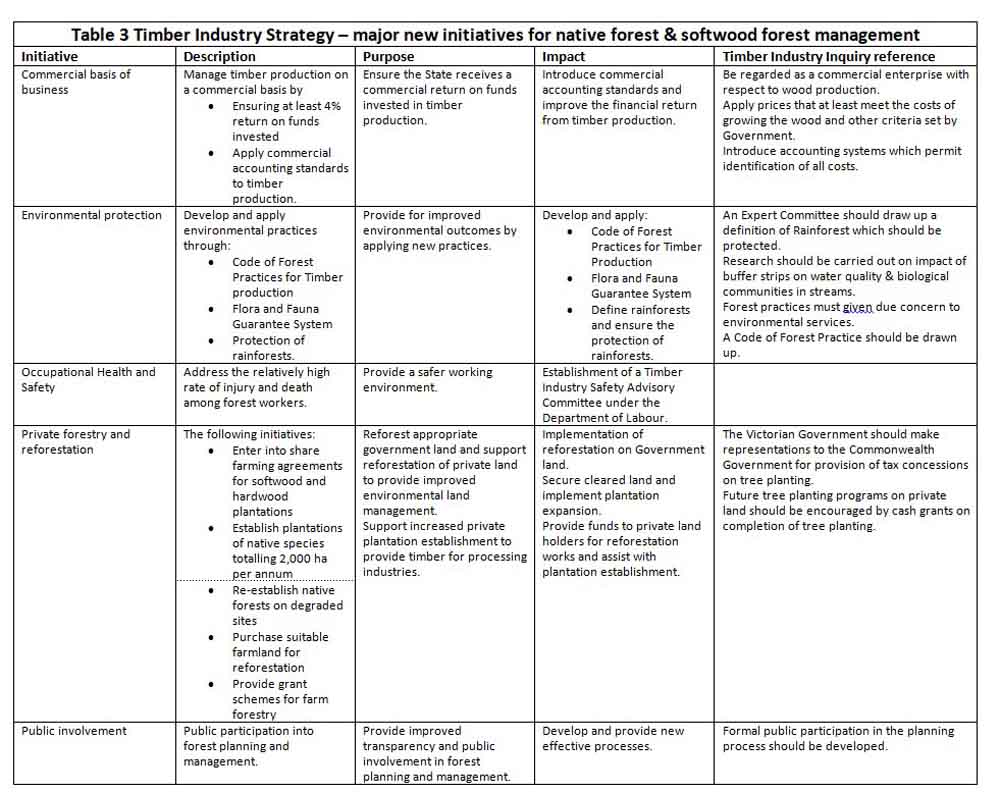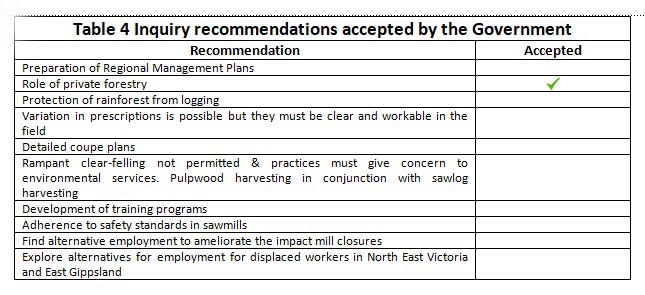Victoria’s Timber Industry Strategy, 1986
D Williams
The new Government elected in Victoria in April 1982 was to intensify the questioning of Victoria's current approach to forest management. On 9th July 1982 the Minister asked the FCV Chairman to establish a number of Task Forces consisting of Commission Officers, to examine:
- Softwood Futures.
- Hardwood Futures.
- Relationships with other Land Managers.
- The Organisation of the Commission.
- The Public Image of the Commission.
- Fire Prevention and Fuel Reduction Burning.
In his Memorandum to the Chairman, the Minister made it clear that the Task Forces exercise was designed to show a new sense of purpose, support from the Government for the Commission to encourage staff involvement, and to open up alternative options each of which he wanted to see fully examined. And later in July 1982 the Minister asked the FCV to establish a Task Force to "report on wood production (hardwood and softwood) and the timber industry in Victoria and to list options for the Government". The specific terms of reference for this work were set out in considerable detail.
On 30 September 1982 the Task Force presented its report to the Minister and the Ministerial Review Team. Due to the comprehensive and detailed nature of this document, the Task Force was asked by the Minister to comment on its preferred options for future wood production.
The Task Force then produced a supplementary report to the Minister in October 1982. This report was titled "Preferred Options for Future Wood Production in Victoria" and added to it in this online copy are the Terms of Reference given to the Task Force, and the Minister's letter outlining the approach to the work that was to be adopted.
Adding to this knowledge base, there followed a lengthy period of inquiry and consultation leading to the Timber Industry Inquiry commencing in 1984. As part of this process the FCV established a task force to update and expand on these earlier reports. This new group of FCV officers, comprised of middle level managers, finalised its report in July 1984 with yet another comprehensive document titled "A Discussion Paper to Assist the DCF&L Prepare a Submission to the Inquiry". While we hold a copy of this document it is too large to make available online in its entirety at this stage, but extracts will appear on the site as we work through the content.
All of the above work helped shape thinking about how our forests should be managed that was to flow into the Timber Industry Strategy of 1986, as described below by David.
Summary
The Victorian Government released a Timber Industry Strategy in 1986 (TIS 1986) to provide a framework for the development of sustainable and competitive timber industry with improved environmental outcomes and including public involvement in forest planning and management. The Strategy was comprehensive covering native forest and softwood forest management, environmental protection and greater public involvement, and included a number of major initiatives. The Strategy was a prototype for similar changes in other States and for the 1992 (2nd edition 1995) National Forest Policy.
The Government established a Board of Inquiry in 1984 to make recommendations on future directions for the timber industry. The Inquiry proactively sought public input into the review and its’ report largely informed the Strategy.
The native forest management initiatives represented major changes or evolutionary steps at the time. Detailed description and implementation was often complex and difficult requiring extensive training of government officers as well as contractors and timber customers. The native forest management changes were seen as disadvantaging some timber customers whilst others were advantaged. The initiatives covered implementing regional sustained yield, multiple use management, changes to silvicultural practices, issuing long term supply arrangements with payment of licence fees and public tender processes for sale of uncommitted timber.
Changes for state owned softwood plantations included issuing long term licences and agreements with payment of licence fees, plans to expand plantations and cessation of clearing native forests for establishing plantations.
Initiatives covering both native forests and softwood plantations included managing the businesses as commercial enterprises ensuring at least four per cent return on invested funds in timber production, environmental protection measures, assisting and encouraging private forestry and reforestation, and effective processes for public involvement.
In the bush the Strategy foreshadowed a significantly upgraded focus on occupational and safety issues, prior training and accreditation, and a licensing system for ‘forest workers/operators’.
Timber industry issues had been stridently contested for more than a decade and a half at the time so stakeholder acceptance of the Strategy was challenging. The Strategy sought a reasonable and pragmatic balance on between social, economic and environmental issues and was accepted by the opposing parties at the time, at least in the short term. The native forest wars re-ignited during the Labor Government’s fourth term several years later, with conservationist campaigning for new national parks and anti-pine groups campaigning against plantation expansion.
Overall the Strategy represented the first comprehensive ‘triple bottom line’ approach to forest management in Victoria and included a number of far sighted initiatives. The Strategy is judged to have been successful in largely achieving its’ objectives in the short term and laying down positive new practices, a number of which endure.
Background
The Victorian Government released its’ Timber Industry Strategy in August 1986. The Strategy had been prepared within the framework of the Government’s State Economic and Conservation Strategies. It represented a balance between social, economic and environmental considerations in the management of forests and support for the timber processing industries. The Strategy aimed to provide:
- Sustainable competitive timber industry
- Improved environmental outcomes
- Public involvement in the planning and management of Victoria’s forests.
The Strategy was Victoria’s first comprehensive statement regarding forests and the timber industry and was the most advanced approach in Australia at the time. It was developed at a challenging time following more than a decade and a half of controversy over the management of native forests and the realisation that the level of harvesting was unsustainable in some regions.
The main focus was on native forests although softwood plantations and reforestation were also included. It was notable as a comprehensive strategy that included a number of far sighted policies and initiatives, some of which were new to Australian forestry.
This report reviews the major new initiatives, the derivation and processes for informing the Strategy, responses by stakeholders and the success and lasting changes to forest management and the timber industry.
Major New Initiatives
The strategy covered a wide range of matters and major initiatives in the following areas:
- Management and silviculture
- Log sales, allocation and pricing
- Commercial basis of the business
- Improving resource recovery and timber processing
- Plantation expansion targets
- Commercial basis of the business
- Cessation of native forest clearing for plantation establishment
Occupational Health and Safety.
Public involvement in forest planning and management.
A number of major new initiatives are summarised in Tables 1, 2 and 3 below. The tables summarise the description, purpose and impacts of the initiatives as well as listing the reference from the Timber Industry Inquiry (Timber Industry Inquiry, 1985).
These initiatives individually and collectively represented major changes to status quo at the time. The descriptions of the initiatives were detailed and implementation was often complex and difficult requiring extensive training of government officers as well as contractors and timber customers. The changes were in many cases seen as disadvantaging contractors and timber customers through the need to change work practices which in some cases were, at least initially, less productive, reductions in supply for some and changes in sale arrangements of timber.
The regional sustained yield and value added allocation of logs were disadvantageous to a number of sawlog customers and their contractors. Native hardwood sawlog harvest required a reduction of 14 per cent state wide and the reduction in East Gippsland was more than 20 per cent. Some sawlog customers experienced reduced supply to align harvest with sustained levels. Other sawlog customers were advantaged by receiving a supply of higher quality logs which they were to process into higher valued products. This required investment in new processing equipment and marketing of the new products. Other customers received a lower quality parcel of logs as the higher quality logs in the supply they previously received were directed to other customers. The value added quality allocation of logs required the development and implementation of a new log grading system which was complex, relied of judgements of internal log defect and quick assessments of external log features. The logs were graded by contractors employed by sawmillers but under instruction from government forest officers thereby creating commercial tension. The log grading was often contested and remained a challenging element of the new system.
Evaluation of more environmentally sensitive alternative silvicultural systems was a large program of trials overseen by a group with external and internal membership. Clear-felling was a major point of contention with conservationists. Subsequent implementation of the findings of the trials involved major changes to forest management practices.
Improved supply certainty through longer term licences and agreements to existing licence and agreement holders, and development of tender and auction systems for unallocated timber were new procedures that were developed and implemented.
Recognising the production of timber and non-timber products as commercial businesses and requiring set rates of return on invested funds was a change to the previous financial approach. The setting up of commercial accounts was also a new challenge.
Cessation of native forest clearing for softwood plantation establishment required purchase of cleared land. Reforestation programs and encouragement and assistance for private forestry were significant tasks.
The target for plantation expansion of 33,700 hectares required the funding and acquisition of sufficient and suitable land base by purchasing farmland. Previous rate of farmland purchase demonstrated the expansion targets represented an ambitious commitment.
New environmental protection initiatives needed to be developed and implemented. The Code of Forest Practices for Timber Production and the Flora and Fauna Guarantee system were complex initiatives and extensive processes that were to be enshrined in legislation and then implemented. The definition and protection of rainforests was another environmental protection initiative.
Processes to improve transparency and provide for public involvement in forest planning and management were developed and implemented. They have since evolved considerably.
Collectively the policies and initiatives represented an unprecedented and complex work challenge.



Where Did the Strategy Come From?
The Strategy was developed in what was at the time a substantially changed political environment. The new Cain government won election in 1982 after 27 years of unbroken Liberal governments. The Cain government was the first Labor government since the previous one led by John Cain’s father lost office in 1955.
Environmental groups had for some time been developing close relations and working within the Labor Party in anticipation of their coming to power. There had been much preparation for government with active internal party committees preparing policies for most areas of government including conservation and forests. Environmental groups were able to advance their policies through their strong representation on relevant policy committees.
The new government reorganised the forest and land management bureaucracy by combining the old agencies for forests, Crown lands and conservation into a new Department of Conservation, Forests and Lands to reflect the Government’s intended approach. The new Department was to consolidate all public land management in one Department in order to better co-ordinate the use of all resources, to rationalise the many different authorities and land management systems, and to properly integrate land use and management with conservation requirements ensuring the protection of native flora and fauna and their environments.
The Strategy had a long gestation within the Labor party starting well before the party won government in 1982. Premier John Cain (Cain 1995) indicates the Labor party had been battling over conservation issues for a number of years before coming to government. There were major internal conflicts during the period of considerable policy development work. There was also a belief in consultative processes as a means of resolving differences between conflicting parties.
The Labor Party brought these approaches into government and applied them to the development of a timber industry strategy as well as other conflicted areas of government.
The commencement of the development of a strategy was the establishment of a Board of Inquiry into the Timber Industry in April 1984 under the direction of Professor Ian Ferguson. The Inquiry was to investigate and report non all aspects of the timber industry in Victoria. The Inquiry was to provide options for a long-term strategy for the development of Victoria’s timber and forest products industries consistent with the Government’s social, economic, employment and environmental policies and objectives. The Inquiry presented its’ report in June 1985 (Timber Industry Inquiry, 1985).
Tables 1, 2 and 3 above summarise the major new initiatives in the Strategy together with the Timber Industry Inquiry reference for each initiative. The tables show a strong correlation between recommendations of the Inquiry and Timber Industry Strategy. The Government released its’ response the Inquiry’s recommendations shortly following the publication of the report in 1985. It specifically accepted a number of recommendations and invited further public comment on some other recommendations with the purpose of providing further public input into the development of the Strategy. Table 4 lists the accepted recommendations. A number of the other recommendations were subsequently included in the Strategy following public responses, albeit in modified form.

Clearly the Strategy was largely informed by the Inquiry. One area where the Strategy and the Inquiry diverge is in relation to the regional sustained yield. The Inquiry recommended against applying the sustained yield model and recommended that the objective of net social benefits should be used.
A contributor to the success of the Inquiry was the extensive consultation process employed. The Inquiry included two rounds of public hearings, a number of field inspections and commissioned external work to address specific topics. The Inquiry received almost 500 submissions. Some of the Inquiry’s recommendations were released by the Government for further comment as input into the Strategy.
Was it Accepted by Stakeholders?
The native forest management situation faced by the newly elected Labor Government in 1982 was fraught. Conservationists had been in strident conflict with timber industry and unions for almost two decades at the time. Conservationists were increasingly critical of the environmental effects of native forest harvesting and were frustrated by what they regarded as their limited voice with Liberal governments that had been in power for almost three decades. They were opposed by timber industry and unions concerned about protecting livelihoods and businesses. It appeared as an intractable dilemma for governments. Prior attempts at reaching co-existence had been largely unsuccessful.
This circumstance was not surprising to the Labor Party when it came to government. Premier John Cain noted that “the party had been battling over conservation issues long before ‘green’ became fashionable in political circles” (Cain 1995). The approach was to seek co-existence between the parties by instituting an open and thorough public review of the timber industry. All parties would be given the opportunity to put their cases and also observe the alternative arguments put by their opponents. The outcome was to be a balance between the social, economic and environmental considerations as reflected in the wide range of public submissions.
The process seemed to be relatively successful as the Strategy was reasonably accepted by the opposing parties, at least in the initial phases. Premier Cain observed “that both the timber industry and unions on the one hand, and the conservationists on the other, had a modest list of complaints about the strategy indicated that we had just about got it right and found a satisfactory middle ground”.
The Labor Government was re-elected in 1988. Environmental politics and the native forest wars were not significant issues in the election campaign. In this respect the Strategy may be regarded as successful in providing a reasonable balance on native forest issues that was accepted by the opposing parties at the time.
However, opposition to softwood plantations based on adverse environmental effects and planned expansion of softwood plantations announced in the Strategy became politically significant requiring specific responses following the release of the Strategy. The Government established an external Plantation Impact Study in 1989 to recommend on plantation issues following which in 1990 Premier Joan Kirner announced the Government’s intention to privatise the government plantation estate.
The native forest wars re-ignited again during the Labor Government’s fourth term. Conservationists campaigned for major new national parks to be established, including in East Gippsland.
Measuring Success
The Strategy was based on the following principles:
- Sustainable competitive timber industry
- Improved environmental outcomes
- Public involvement in the planning and management of Victoria’s forests.
Looking back more than three decades to assess whether the Strategy successfully achieved these objectives is problematic. How should one assess ‘success’ with continuously changing community expectations regarding the use of Victoria’s native forests? Our broader community expectations continue to evolve. As a nation we continue to urbanise, while seemingly placing an increasingly value on preservation of our native forests; and successive governments have responded by creating new national parks, other conservation reserves and placing increasing environmental restrictions on reducing timber harvesting operations. This trend is observed throughout Australia and in developed overseas countries. Natural forests are increasingly managed primarily for nature conservation with much reduced or no timber production in other countries in Europe and North America. Assessment of whether the Strategy achieved the objective of creating a sustainable competitive timber industry needs to be seen in this context.
The native forest timber industry is a shadow of what was envisaged by the Strategy. The production of sawlogs from public native forests declined by 46% from 1,086,206 cubic metres in 1985 over the following two decades (The Allen Consulting Group 2006). In this sense the Strategy did not achieve the objective. However, a number of the native forest management initiatives positively changed practices and represented new approaches subsequently adopted in other jurisdictions. The softwood plantation business was corporatised in 1993 and then subsequently privatised in 1998. The private business has successfully operated on a profitable basis and continues to supply logs to an expanded and competitive processing industry. The softwood plantation sector outcome has been successful but not in the manner proposed under the Strategy.
Environmental management prescriptions and outcomes in native forests are of a very high standard and continue to evolve. The Strategy’s specific environmental protection initiatives were ground breaking at the time and have endured. The extensive defined processes for public involvement also represented new steps at the time which have continued to evolve.
Overall the Strategy represented the first strategic approach to forest management in Victoria and included a number of far sighted initiatives. The Strategy is judged to have been successful in largely achieving its’ objectives in the short term, in laying down positive new practices, a number of which endure.
Conclusions
The Timber Industry Strategy was Victoria’s first comprehensive “triple bottom line” government statement on the management of the State’s forests. It sought to strike a balance between social, economic and environmental considerations in providing for the development of a sustainable and competitive timber industry. It was far sighted and arguably ground-breaking nationally and incorporated a number of new positive initiatives that were long-lasting.
Within a political environment where there had been intense conflict for a decade and a half, the Strategy provided a reasonable level of coexistence between opposing parties, at least for a short time. The Strategy was successful in this regard. It was also successful in providing a number of positive initiatives that were new to Australian forestry and were subsequently implemented by other forest services. Inevitably though, the largely urban-based ‘forest wars’ returned and the Government responded to public protests with changes that undermined more than a few of the Strategy’s initiatives.
See Also: Timber Industry Inquiry - Discussion Paper by CFL 1984
Timber Industry Strategy - Audit, May 1993
References
John Cain’s Years - Power, Parties and Politics. Cain, John 1995. Melbourne University Press.
The Allen Consulting Group, 2006
Victoria’s Forest Industries - Report to the Victorian Association of Forest Industries
Timber Industry Inquiry 1985 - Report of the Board of Inquiry into the Timber Industry
Victorian Timber Industry Strategy- Government Statement No. 9, 1986
